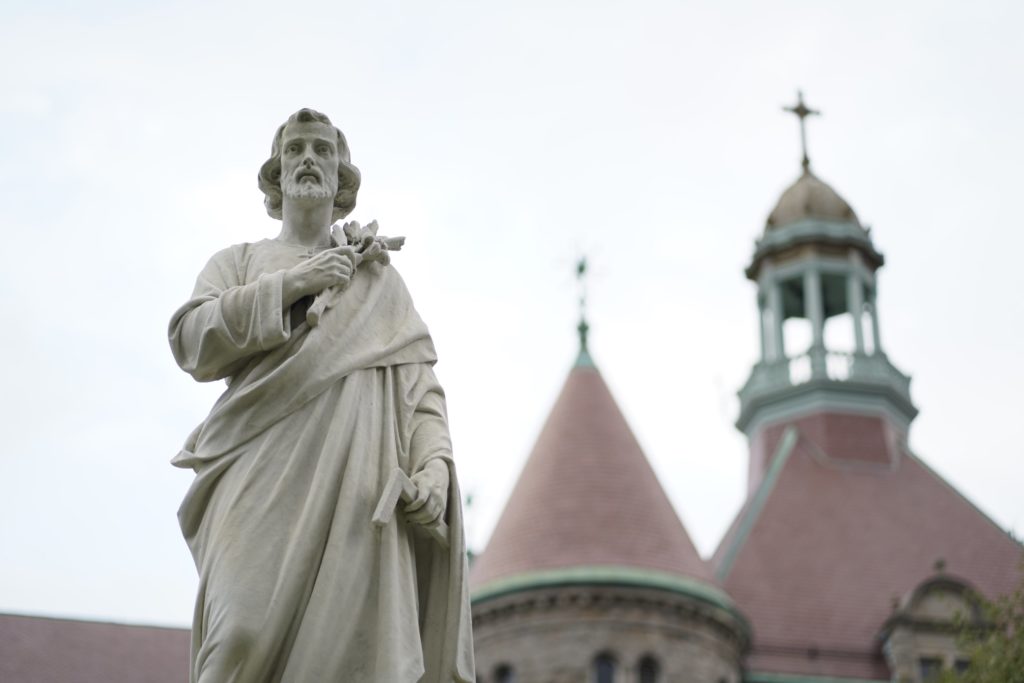To those who complain that the Church gives short shrift to women, I always want to say — Excuse me.
Mary: the “Magnificat,” prayed by every priest and nun in the world each evening at Vespers; Joseph: silence. Mary: the rosary; Joseph: an old-timey cough syrup. Mary: crowned queen of heaven and earth; Joseph: gets his statue buried in the backyard so people can sell — or buy — a house.
With St. Joseph’s feast day coming up on March 19, enter art historian Elizabeth Lev’s “The Silent Knight: A History of St. Joseph as Depicted in Art” (Sophia Institute Press, $18.95).
Lavishly illustrated, the book delivers a lively overview of Joseph’s evolution throughout the centuries in the mind and heart of the Church.
“It is a guidebook of sorts,” writes Lev, “through the numerous historical, apocryphal, and theological vicissitudes of devotion to St. Joseph, revealing how each new facet of veneration produced a different trend in imagery.”
Joseph hardly even featured in Christian art for hundreds of years — an absence that allowed the virgin birth and the divinity of Christ to take firm theological primacy.
He appeared on stage in A.D. 431, the year of the dedication of Rome’s Basilica of St. Mary Major. “Virile and attentive,” clad in a brilliant orange tunic, he was given pride of place on a series of splendid mosaics adorning the church’s triumphal arch.
But during the next many long years Joseph suffered a marked comedown. When he appeared at all he was old, even doddering; a superfluous, sidelined figure playing, at best, a supporting role in salvation history.
He was not even included in the Roman canon that was codified in the seventh century, a liturgical omission that would not be corrected until 1962, by Pope St. John XXIII.
The reliquary boxes, Nativity icons, and mosaics from the centuries leading up to the first millennium are charming. Still, as Lev notes, “Present only in Nativity and Magi scenes, Joseph was depicted as a diminutive figure behind Mary’s throne, or a pensive elder crouched in a corner.”
It was only when the Church began to acquire wealth and political power that Joseph assumed his rightful, chivalric place as protector against corruption, greed, and impurity. After all, in an age that worshipped feudalism, who had a better lineage than Joseph?
St. Bernard became an early champion, and in 1189 the first church dedicated to Joseph was built in Bologna.
In stained glass, frescoes, and a resplendent “Flight to Egypt” by Duccio di Buoninsegna (c. 1308) — a panel from a 16-foot-high altarpiece commissioned by the City of Siena — Joseph is portrayed as both a man of action and a contemplative, guided by angels yet firmly in charge of Mary and the infant Christ on their perilous journey.
During the next couple of centuries the Franciscans and Dominicans — mendicant orders — celebrated Joseph as “an everyday man with a profession and plans.” This Joseph “was called to bear witness to the Incarnation, and, through him, a more vernacular form of praise and worship, perhaps less exalted, but no less sincere, became possible.”
Franciscan artist Giotto’s “Nativity” mural (c. 1320), placed above the tomb of St. Francis in Assisi, is emblematic of this period.
The scene, in “jewel-like” tones of gold and midnight blue, spotlights Mary and the child. Joseph is a pensive, dignified figure on the lower left who serves as protector and will also attend to his son’s earthly needs of clothing and food.
Over time, Joseph came to fulfill myriad other roles in addition to that of father, protective sentinel, and worker.
By the 17th century, painters from France and Italy began to portray his death, and he became a guide into the afterlife.
In 1679, he was selected as patron by the era’s missionaries and morphed into a worldwide evangelist.
In Mexican painter Miguel Cabrera’s “The Patronage of St. Joseph” (1753), a young Joseph, garbed in a floral silver robe, arms outstretched in a maternal embrace and looking, as Lev points out, very much like Jesus, seems to be levitating. Supplicants from every walk of life kneel at his feet, and the white lily he brandishes aloft in his right hand could almost be tickling the chins of the overlooking guardian angels.
When a 19th-century “tsunami of secular forces” — many Enlightenment thinkers and politicians; France’s “Reign of Terror” — threatened the Church, Joseph again swooped in to help save the day.
Pope Gregory XVI (1831-1846) promoted a devotional practice called “the Seven Sundays,” based on a 16th-century miracle attributed to Joseph.
On the feast of the Immaculate Conception in 1870, Blessed Pope Pius IX, desperate to guard his flock, consecrated the entire Church to St. Joseph in the decree “Quemadmodum Deus.”
And so on up to today: 2021 was declared the Year of St. Joseph for the universal Church.
Strangely, however, art depicting Joseph has stagnated.
Notes Lev, “Despite his ubiquity … he has returned to the sidelines of artistic innovation. The statues go unnoticed; his placement at the Nativity, pro forma; his might and authority, almost forgotten. St. Joseph has become so visible as to have become invisible.”
Nonetheless, Lev points to contemporary artists, among them the New York-born Janet McKenzie and young Irish sculptor Dony MacManus: glimmers of hope who “portray handsome men, role models of self-restraint in the modern age of bodily objectification. [These Josephs] are made to love and be loved.”
Never have we needed Joseph more. May we artists get cracking.

